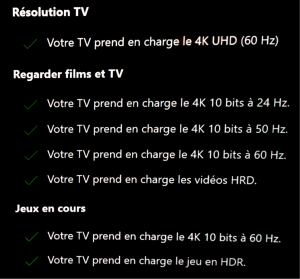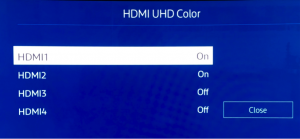Désolé, cet article est seulement disponible en Anglais Américain. Pour le confort de l’utilisateur, le contenu est affiché ci-dessous dans une autre langue. Vous pouvez cliquer le lien pour changer de langue active.
HDR and some NGA are here (well almost). Demos will blow your mind and ears, but beware - it can take a geek a couple of hours to get it working at home.
Here is my personal account, as a simple user, of my road to UHD nirvana in my living room. I wrote this in early September 2016, and just updated it at the end of the month as I finally got Dolby Atmos working and it was worth the wait).
My setup
When I moved to my new flat in central Paris 8 months ago, I immediately got access to an Orange Fibre connexion with speeds of up to 800 Mbps. With all the work I’ve been doing on UHD as a member of the Ultra HD Forum, I saw this as an opportunity to test some streaming services in the real world of my sitting room.
I’ve had my Samsung SUHD TV (UE55SJ8500) for 6 months now. First demos were with still images from the UHD Zoo app, as it took me a while to get a 4K video that I could effectively stream to my TV. Of course, Netflix was available, and although some 4K series have some stunning shots that show up all the new pixels, many don’t, even though they’re in the 4K section.
After having completed a white paper on Object based sound and getting excited about DTS:X (see here), I went for a mid to high-range Onkyo A/V receiver (TX-RZ 810 B ) that was already Dolby Atmos-capable and will be software upgradable to DTS:X.
Having spent 1,200 € on the receiver, I was no longer ready to splash out on the high-end Atmos speaker system I’d been eying. Amazon had a 400€ set of speakers available for next day delivery so I went for an Onkyo SKS-HT588(B) system, knowing that once my system is stable, I’ll have to invest in real speakers.
Sound first
A first hurdle for many viewers will be that the TV set-top-box is usually set by default to stereo sound. So before getting anything like 5.1 output from that source one must find the appropriate sub-menu and set HDMI audio output to what in my case Orange calls Home cinema.

The other option (yes, it’s well known that two options make things simpler!) is to use an optical output from the STB, which is always in pass-through mode, and then configure the AV receiver to associate that with the video, from the Orange STB in my case.
The Orange TV service has had a single Dolby Atmos sports transmission but I couldn’t find any next-gen audio in the VoD library so to get some fancy sound demos, back to the Internet where I found Dolby demo files with difficulty on http://www.demo-world.eu/2d-demo-trailers-hd/.
It turned out none of my devices or software was able to send the Dolby Atmos sound track to my AV receiver. I found on an obscure geek chat that the Kodi video player could decode Atmos. So I installed that onto my Mac and Eureka!, the Dolby Demos played on my TV (connected with HDMI to my Mac). It sounded beautiful, but the Onkyo receiver never had the word ‘Atmos’ appear so I’m guessing it just considered it was Dolby 7.1, but hey, it sounded really immersive with the rain falling literally overhead, so who cares? [see update at end of blog, I did finally get the Atmos to work from the Orange VoD store].
Now for some HDR video
Amazon and Netflix have some UHD content but on their own interfaces, it is so far impossible to tell whether there’s any HDR, and I understand Netflix chooses the HDR mode dynamically, so for the next demo, it seems like physical media is the only way.
Which UHD Blu-ray player?
After waiting for UHD capable Blu-Ray players for a year, I decided to go and get one of the two available in France (The Samsung at 500€ or the Hitachi at 800€). But when I got to the retail store, the sales guy suggested I get an Xbox One S for 400€. That would also hopefully get my sixteen-year-old interested, so I went for that option.
Back home with the Xbox unpacked, my next objective was to get UHD Blu-Ray disks to play and at-long-last see some real HDR.

Inside the Xbox parameters, to select HDR, there is no mention (yet) of HDR itself. You need the knowledge that we are looking for 10-bit colour and so must select the 30 (!?) bits per pixel option (I later used the top 36 (12) bits options, which the TV accepted fine, and the video looked a bit better, strangely I had a better sense of very high resolution rather than amazing colours. There was no HDR wow effect with the Man-of-Steel blue ray I got for free with my Xbox, it just looked very nice.

I then got into the Xbox One S’ advanced video parameters and all of a sudden the HDR word appears. And so now, going into the 4K TV submenu (note the confusion it should be a UHD sub-menu as we’re talking HDR and a bit of HFR too), I was all excited to see all the new possibilities:

But let’s not run away with ourselves, there was a last hurdle to cross. The Xbox’s Blu-ray player said I had the wrong kind of TV for UHD. It turned out that the AV Receiver through which my HDMI signal was passing, was not HDCP 2.2 enabled.

In the Inputs sub-menu of the Onkyo AV receiver, I discovered that only HDMI 1 through 3 were HDCP 2.2-capable. That required pulling the TV away from the wall yet again and reassigning the X-Box One S to one of the 3 first ports (and of course reassigning whatever was already there that didn’t need HDCP 2.2 somewhere else). I’ll spare you the screen shot of doing that in the AV receiver’s menus.

Finally, on my Samsung TV I had to hunt down to the 14th menu item of the main Picture menu, called HDMI UHD Color, which everyone else calls HDR.

Then within the Samsung TV submenu I turned on the HDMI ports that are connected to HDR sources. For each value you change here, the TV needs to reboot (no kidding it really does).

A couple of hours after had I started, my Samsung TV finally tells me I’ve succeeded: full UHD with HDR AKA UHD Color. I am of course too hot and bothered at this stage to want to watch anything, but when I have since shown off my new 4K/HDR/NGA setup, I’ve persistently got the most wows for the immersive audio demos. Hmmm, maybe I should have just bought a new stereo… nah, just kidding 😉
Wrapping up
Putting my professional hat on, I’m still a true believer in UHD and all its promises, but despite having often written about “This being the year for UHD”, I do see that there is a potential blocking point with these customer-facing issues. I trust that at the Ultra HD Forum and the UHD Alliance folks will get to grips with these interoperability teething problems so that the true benefits of UHD aren’t confined to the tech-savvy. I see a great opportunity for operators and their call centres to fix wires problems today but also for the CPE suppliers to work on processing HDR and one day NGA locally. UHD has to be plug and play to truly take off.
[Update Sept 29 2016: I spent 10€ on a digital copie of Salt (Angelina Jolie) from the Orange VoD store that had about 9 other movies with Atmos at time of writing - so Yeah! I finally got my expensive A/V receiver to actually recognise an Atmos audio stream and generate the right output. The sense of immersion is clearly improved, you really can't tell what's coming out of what speaker any more and I heard sounds that seemed to come from "in front of a given speaker".
If on an imaginary quality scale 1 is bad mono (i.e. the phone), the a jump to good stereo would bring a real wow-effect probably scoring maybe 5, moving from stereo to 5.1 is another similar wow-effect say doubling the score to 10. Object based sound on top of 5.1 (or 5.1.2 in my case) brings another really noticeable improvement, but less of a wow-effect, so I'd subjectively say my current system scores 12 on my imaginary scale.]












